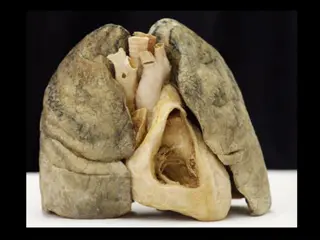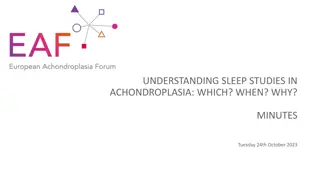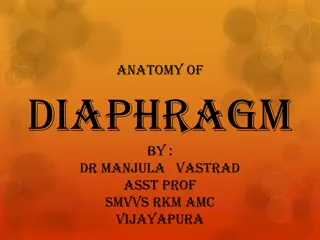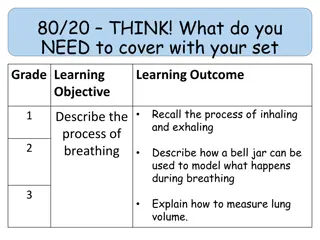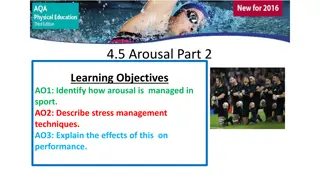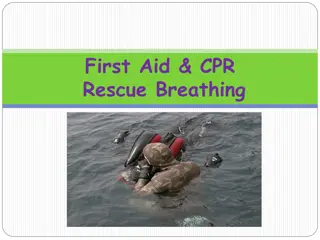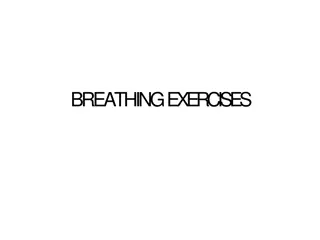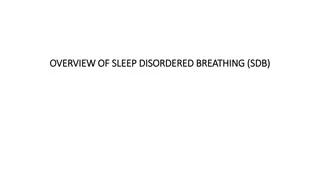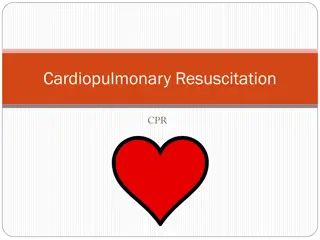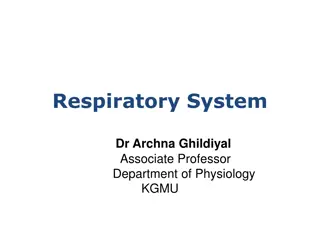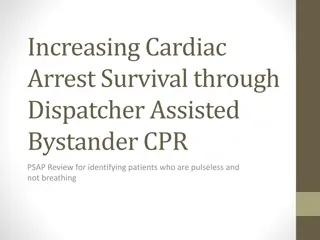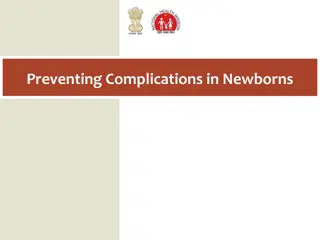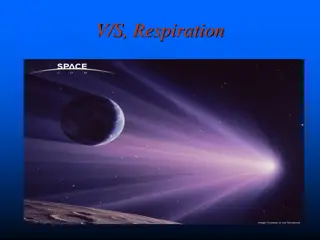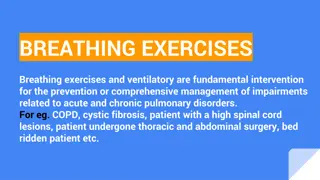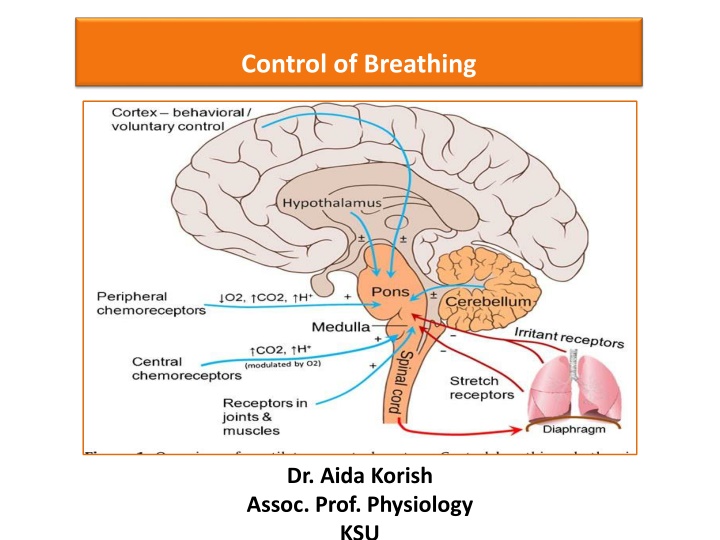
Control of Breathing: Respiratory Physiology Insights
Delve into the intricate mechanisms of respiratory control, exploring the role of the medulla oblongata, factors influencing breathing patterns, and the significance of arterial PO2, PCO2, and pH. Gain insights into the function of medullary respiratory centers and their role in regulating respiration. Unravel the complexities of respiratory physiology in this comprehensive lecture.
Download Presentation

Please find below an Image/Link to download the presentation.
The content on the website is provided AS IS for your information and personal use only. It may not be sold, licensed, or shared on other websites without obtaining consent from the author. If you encounter any issues during the download, it is possible that the publisher has removed the file from their server.
You are allowed to download the files provided on this website for personal or commercial use, subject to the condition that they are used lawfully. All files are the property of their respective owners.
The content on the website is provided AS IS for your information and personal use only. It may not be sold, licensed, or shared on other websites without obtaining consent from the author.
E N D
Presentation Transcript
Control of Breathing Dr. Aida Korish Assoc. Prof. Physiology KSU
Objectives By the end of this lecture you should be able to: - Understand the role of the medulla oblongata in determining the basic pattern of respiratory activity. List some factors that can modify the basic breathing pattern like e.g. a- The Hering-Breuer reflexes, b- The proprioreceptor reflexes, c- The protective reflexes, like the irritant reflex, and the J-receptors reflex. Understand the respiratory consequences of changing PO2, PCO2, and PH. Describe the locations and roles of the peripheral and central chemoreceptors. Compare and contrast metabolic and respiratory acidosis and metabolic and respiratory alkalosis.
Controls of rate and depth of respiration The goal of respiration is to maintain proper concentrations of O2, CO2, and H+ in the tissues. The nervous system normally adjusts the rate of alveolar ventilation almost exactly to the demands of the body. The respiratory activity is highly responsive to changes in each of these substances. Arterial PO2 When PO2 is VERY low (Hypoxia), ventilation increases in rate and depth i.e the patient will hyperventilate. Arterial PCO2 The most important regulator of ventilation is PCO2, small increases in PCO2, greatly increases ventilation. Arterial pH As hydrogen ions increase (acidosis), alveolar ventilation increases.
Respiratory Center It is divided into the following collections of neurons: (1) A dorsal respiratory group (DRG), located in the dorsal portion of the medulla, which mainly causes inspiration. (2) A ventral respiratory group (VRG), located in the ventrolateral part of th medulla, which mainly causes forced expiration. (3) The pneumotaxic center, located dorsally in the superior portion of the pons. It mainly controls rate and depth of breathing by turning off the inspiratory signals from the DRG. (4) The apneustic center: located in the inferior potion of the pons, it turns on stimulatory impulses to the DRG of neurons.
The Medullary Respiratory centers Inspiratory area (Dorsal Respiratory Group) DRG: Located within the nucleus of the tractus solitaries (NTS), which is the sensory termination of both the vagal (X) and the glossopharyngeal nerves (IX) (which transmit sensory signals into the respiratory center from: Peripheral chemoreceptors, baroreceptors and several types of receptors in the lungs. Function of DRG: -It determines basic rhythm of breathing. -It causes contraction of diaphragm and external intercostals. Expiratory area (Ventral Respiratory Group) VRG -Although it contains both inspiratory and expiratory neurons. It is totally inactive during normal quiet breathing. -Activated by the inspiratory area (DRG) during forceful breathing. Function of VRG: It causes contraction of the abdominal muscles during forced breathing. The medullary respiratory centers stimulate basic inspiration for about 2 seconds and then basic expiration for about 3 seconds (5 sec/ breath = 12 breaths/min).
Pontine Respiratory centers Transition between inhalation and exhalation is controlled by: Pneumotaxic area Inhibits the inspiratory area of medulla to stop inhalation. limitation of inspiration also shortens expiration and the entire period of each respiration. Therefore, breathing is more rapid when pneumotaxic area is active. Apneustic area Stimulates the inspiratory area of the medulla to prolong inhalation. Therefore, if it is stimulated, it prolongs the respiratory cycles and slows the respiration rate.
Hering-Breuer inflation reflex When the lung becomes overstretched (tidal volume is (> 1.5 L/breath), the stretch receptors located in the wall of bronchi and bronchioles transmit signals through the vagus nerve to DRG producing effect similar to pneumotaxic center stimulation: It Switches off inspiratory signals and thus stops further inspiration . This reflex also increases the rate of respiration as does the pneumotaxic center. This reflex appears to be mainly a protective mechanism for preventing excessive lung inflation.
Other factors that affect respiration Irritant receptors in the airways. The epithelium of the trachea, bronchi, and bronchioles is supplied with sensory nerve endings called pulmonary irritant receptors. These receptors initiate coughing and sneezing They may also cause bronchial constriction in persons with diseases such as asthma and emphysema. Lung J receptors: sensory nerve endings in the alveolar walls in juxta position to the pulmonary capillaries. Are stimulated when the pulmonary capillaries become engorged with blood or when pulmonary edema occurs in congestive heart failure. Their excitation may give the person a feeling of dyspnea.
Chemical Control of Respiration Peripheral and central chemoreceptors Most of the peripheral chemoreceptors are in the carotid bodies. However, a few are also in the aortic bodies. They send impulses to the inspiratory neurons (DRG) through CN: IX and X. The central chemoreceptors are located under the ventral surface of the medulla oblongata and has direct connections with the inspiratory area (DRG).
Effect of changes of CO2 , H+ levels Excess CO2 or H+ in the blood stimulate the central chemoreceptors which act on the respiratory center, causing increased strength of both the inspiratory and the expiratory motor signals to the respiratory muscles (hyperventilation). Also increased CO2 or H+ concentration in blood simulate the peripheral chemoreceptors and increases respiratory activity. The effects of CO2 or H+ on the central chemoreceptors are (about seven times) more powerful than their effects on the peripheral chemoreceptors . However, the stimulation of the peripheral chemoreceptors occurs five times as rapidly as the central stimulation, So the peripheral chemoreceptors might be especially important in increasing the rapidity of response to CO2 at the onset of exercise.
Direct effect of H+ ions on the central chemoreceptors The central chemoreceptors are especially excited by H+ ions. In fact, it is believed that H+ ions may be the only important direct stimulus for these neurons. However, The blood- brain barrier (BBB) is nearly impermeable to H+ ions, but CO2 passes this barrier very easily. For this reason, changes in H+ ion concentration in the blood have considerably less effect in stimulating the centeral chemosensitive neurons than do changes in blood CO2 even though CO2 is believed to stimulate these neurons secondarily by changing the hydrogen ion concentration.
Why does blood CO2 have a more potent effect in stimulating the chemo sensitive neurons than do blood H+ ions? Although CO2 has little direct effect in stimulating the neurons in the chemosensitive area, it does have a potent indirect effect. When the blood PCO2 increases, so does the PCO2 of both the interstitial fluid of the medulla and the cerebrospinal fluid (CSF). In these fluids, the CO2 reacts with the water to form new H+ ions. Thus, more H+ ions are released into the respiratory chemosensitive sensory area of the medulla when the blood CO2 concentration increases than when the blood H+ ion increases. For this reason, respiratory center activity is increased very strongly by changes in blood CO2.
A change in blood CO2 concentration has a potent acute effect on controlling respiratory drive but only a weak chronic effect after a few days adaptation. Excitation of the respiratory center by CO2 is great after the blood CO2 first increases, but it gradually declines over the next 1 to 2 days. Part of this decline results from renal readjustment of the H+ ion concentration in the circulating blood back toward normal after the CO2 first increases. The kidneys increasing the blood HCO3-, which binds with H+ ions in the blood and CSF to reduce their concentrations. Over a period of hours, the HCO3- ions slowly diffuse through the BBB CSF barriers and combine directly with the H+ ions adjacent to the respiratory neurons as well, thus reducing the H+ ions back to near normal.
Peripheral Chemoreceptor System Activity Role of Oxygen in Respiratory Control When the oxygen concentration in the arterial blood falls below normal, it acts almost entirely on peripheral chemoreceptors, The impulse rate is particularly sensitive to changes in arterial PO2 in the range of 60 down to 30 mm Hg. Under these conditions, low arterial PO2 obviously drives the ventilatory process quite strongly. Because the effect of hypoxia on ventilation is modest for PO2 values greater than 60 to 80 mm Hg, the PCO2 and the hydrogen ion response are mainly responsible for regulating ventilation in healthy humans at sea level.
Respiratory Acidosis Respiratory Alkalosis Hyperventilation. Excessive loss of CO2. PCO2 decreases ( 35 mmHg). pH increases. Hypoventilation. Accumulation of CO2 in the tissues. PCO2 increases pH decreases.
Metabolic Acidosis Metabolic Alkalosis Excessive loss of fixed acids from the body Ingestion, infusion, or excessive renal reabsorption of bases such as bicarbonate pH increases. Ingestion, production of a fixed acid. Decreased renal excretion of hydrogen ions. Loss of bicarbonate or other bases from the extracellular compartment. Metabolic diabetic ketoacidosis. infusion, or disorders as The respiratory system can compensate for metabolic acidosis or alkalosis by changing alveolar ventilation


